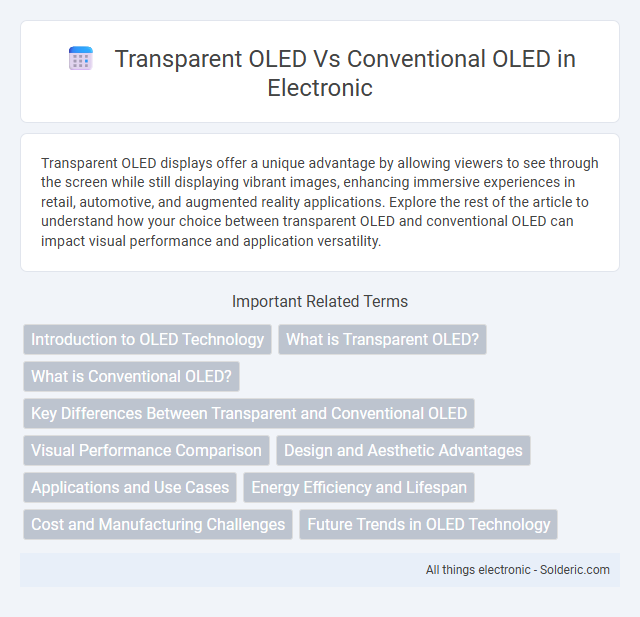Transparent OLED displays offer a unique advantage by allowing viewers to see through the screen while still displaying vibrant images, enhancing immersive experiences in retail, automotive, and augmented reality applications. Explore the rest of the article to understand how your choice between transparent OLED and conventional OLED can impact visual performance and application versatility.
Comparison Table
| Feature | Transparent OLED | Conventional OLED |
|---|---|---|
| Display Type | See-through, allows background visibility | Opaque, no background visibility |
| Transparency | Up to 40-45% visible | 0% (non-transparent) |
| Use Cases | Retail displays, smart windows, augmented reality | Smartphones, TVs, monitors |
| Brightness | Lower compared to conventional OLEDs | High brightness, vivid colors |
| Contrast Ratio | Moderate, affected by transparency | High, deep blacks and vibrant colors |
| Thickness | Thinner due to transparent substrates | Standard thickness, non-transparent layers |
| Power Consumption | Generally higher to compensate brightness | Lower power per brightness unit |
| Cost | Higher due to complex manufacturing | Lower, widely mass-produced |
Introduction to OLED Technology
OLED technology utilizes organic compounds that emit light when an electric current passes through them, offering superior color accuracy and contrast compared to traditional displays. Transparent OLEDs incorporate a unique design that allows light to pass through the screen, enabling see-through displays without sacrificing image quality. Your choice between transparent and conventional OLED depends on whether you prioritize innovative display features or classic vibrant visuals.
What is Transparent OLED?
Transparent OLED is a cutting-edge display technology that allows screens to show images while remaining see-through when not in use, utilizing organic light-emitting diodes arranged on a transparent substrate. Unlike conventional OLEDs, which have opaque backplanes, Transparent OLEDs enable immersive augmented reality experiences and sleek design applications by maintaining high color accuracy and brightness without obstructing the viewer's line of sight. Your choice of Transparent OLED can revolutionize advertising, retail displays, and smart windows by seamlessly blending visuals with the surrounding environment.
What is Conventional OLED?
Conventional OLED (Organic Light Emitting Diode) displays consist of multiple layers where organic compounds emit light when an electric current passes through, producing vibrant colors and deep blacks on an opaque screen. Unlike transparent OLEDs, traditional OLED panels do not allow light to pass through, making them ideal for TVs, smartphones, and monitors with high contrast and energy efficiency. Your viewing experience benefits from the superior color accuracy and faster response times inherent in conventional OLED technology.
Key Differences Between Transparent and Conventional OLED
Transparent OLEDs feature a unique design that allows light to pass through the display, enabling see-through visuals and creating innovative applications in augmented reality and heads-up displays. Conventional OLEDs emit light from an opaque panel, providing vibrant colors and high contrast ideal for traditional screens like smartphones, TVs, and monitors. The primary differences lie in transparency capability, design complexity, and typical use cases, with transparent OLEDs offering futuristic, interactive experiences while conventional OLEDs prioritize rich visual performance.
Visual Performance Comparison
Transparent OLED displays offer superior visual performance compared to conventional OLEDs by combining vibrant colors and deep blacks with see-through capabilities, enabling immersive augmented reality applications. Conventional OLEDs provide higher contrast ratios and brightness levels suitable for traditional displays but lack transparency, limiting their use in innovative visual interfaces. Transparent OLED technology enhances user experience in retail, automotive, and smart glass applications by delivering crisp images without obstructing the viewer's line of sight.
Design and Aesthetic Advantages
Transparent OLED displays offer superior design flexibility by enabling screens that can blend seamlessly into environments, allowing for innovative applications like window displays and augmented reality interfaces. Unlike conventional OLEDs, transparent OLEDs maintain high image quality while permitting light and objects to be visible through the display, enhancing aesthetic appeal without compromising functionality. This transparency feature supports minimalist design trends, making devices and installations appear less intrusive and more visually engaging.
Applications and Use Cases
Transparent OLED technology enables innovative applications in augmented reality displays, smart windows, and heads-up displays for automotive and retail sectors. Conventional OLEDs are predominantly used in smartphones, televisions, and wearable devices where vibrant color reproduction and flexibility are critical. Transparent OLEDs provide added value in space-saving solutions and interactive retail signage by combining high transparency with dynamic visual content.
Energy Efficiency and Lifespan
Transparent OLED displays typically consume less energy than conventional OLEDs due to their ability to modulate transparency and reduce backlighting needs, enhancing overall energy efficiency. Conventional OLEDs often have a longer lifespan because their layered structure is optimized for durability and consistent brightness, whereas transparent OLEDs may face challenges with longevity due to exposure to ambient light and environmental factors. Choosing your display depends on balancing the innovative energy-saving benefits of transparent OLED technology against the proven durability of conventional OLED panels.
Cost and Manufacturing Challenges
Transparent OLED panels incur higher production costs due to complex layer deposition techniques and the necessity for advanced transparent electrodes, unlike conventional OLEDs which utilize established manufacturing processes. The intricate fabrication of transparent OLEDs demands precise control to maintain transparency and display performance, increasing yield loss and manufacturing time. Cost-effectiveness of transparent OLED technology remains a challenge compared to conventional OLEDs, limiting widespread adoption in consumer electronics.
Future Trends in OLED Technology
Transparent OLED technology is poised to revolutionize display applications by enabling seamless integration of digital content into real-world environments, fostering innovations in augmented reality, smart windows, and automotive head-up displays. Conventional OLED panels continue to advance in brightness, efficiency, and lifespan, but transparent OLEDs offer unparalleled potential in creating immersive, interactive surfaces with dynamic transparency control. Future trends emphasize hybrid OLED systems combining transparency with flexibility and higher resolution, driving widespread adoption in consumer electronics and architectural design.
Transparent OLED vs Conventional OLED Infographic

 solderic.com
solderic.com